Reading the Avon Fantasy Reader — Issue 1: What Defines a Classic?
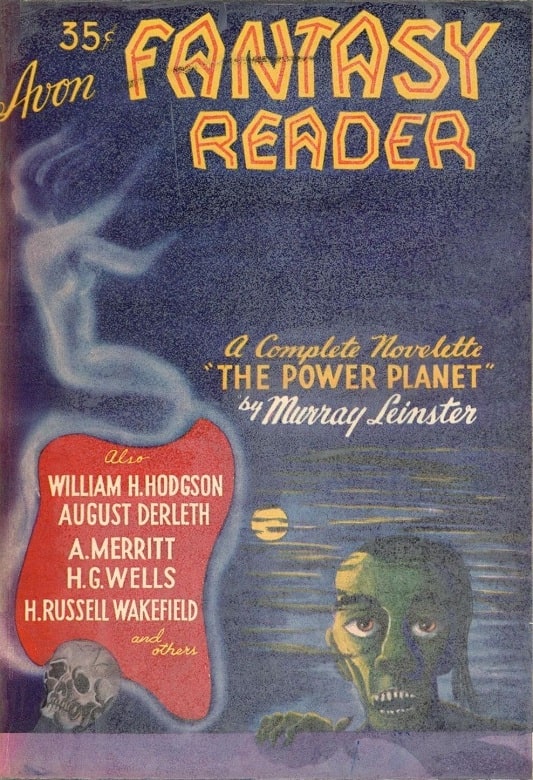 |
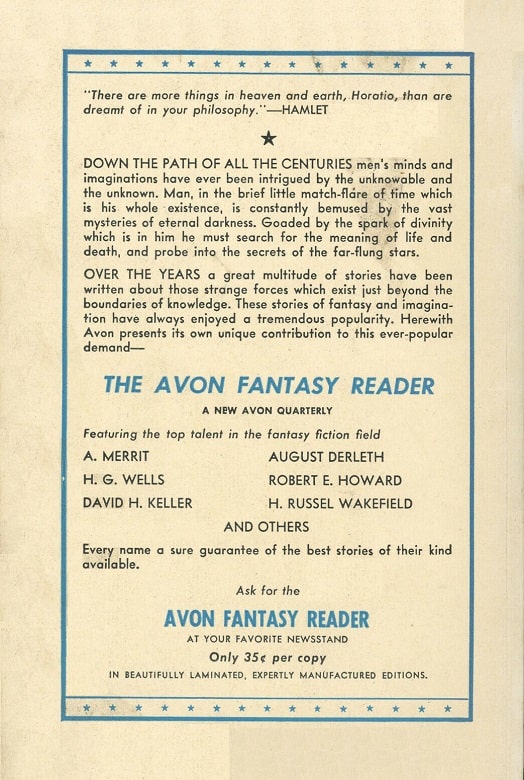 |
Avon Fantasy Reader #1 (Avon Books, February 1947). Cover artist unknown
On the occasion of this year’s Windy City Pulp and Paper Convention — my fifth — I resolved to learn from past mistakes and come armed with a specific list of items needed to plug holes in my considerable collection of science fiction and fantasy paperbacks and pulps. This year, I came looking to complete my set of all 18 volumes of Donald A. Wollheim’s Avon Fantasy Reader, a digest magazine I’d poked at before due to its propensity to publish works by Clark Ashton Smith, a writer who never disappoints. The convention coughed up all but two of my missing issues, but crucially provided the first volume in the series, which I had never before seen in person. I snagged it immediately, of course, and began reading it that day.
The Avon Fantasy Reader ran 18 issues, from February 1947 to March 1952. Originally intended as a quarterly, it usually managed three issues per year. Wollheim’s introduction to the first volume promises tales of fantasy and imagination about “those strange forces which exist just beyond the boundaries of knowledge.” He further touts a roster of authors that represented “a sure guarantee of the best stories of their kind available.”
[Click the images for classic-sized versions.]
Donald Wollheim’s introduction on the inside of Avon Fantasy Reader #1
A survey of the first issue’s offerings provides a sample of the types of tales Wollheim set out to include in the Reader: pure fantasy, ghost stories, weird tales of the sea, science fiction, futurian conjecture, and tales that “delve beyond the bounds of the past, or of the mind, or even peer behind the façade of the present to find horror and witchcraft.”
“No type of imaginative romancing will be neglected,” he says.
Over its 18 volumes, the Avon Fantasy Reader put forth works by authors like Robert E. Howard, Clark Ashton Smith, A. Merritt, and other foundational writers of early 20th century fantasy fiction. While the magazine did feature contemporary tales in several of its issues, the bulk of its content focused on already “classic” (or at least well-loved by Wollheim) tales from the previous four decades of fantasy (and sometimes even earlier).
Their resurrection here along with the archival work being done in Mary Gnaedinger’s Famous Fantastic Mysteries (1939–1953), Fantastic Novels (1940–1951), and A. Merritt’s Fantasy Magazine (1949–1950) and by other pulp editors in “classic story” features of various magazines of the time, started to establish a sort of “fantasy canon” that held steady for decades, in many cases to the present day.
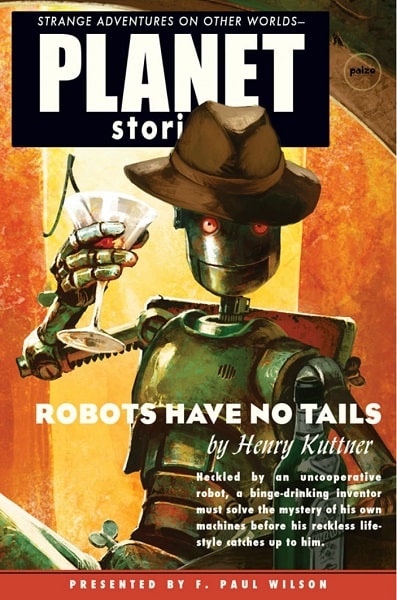 |
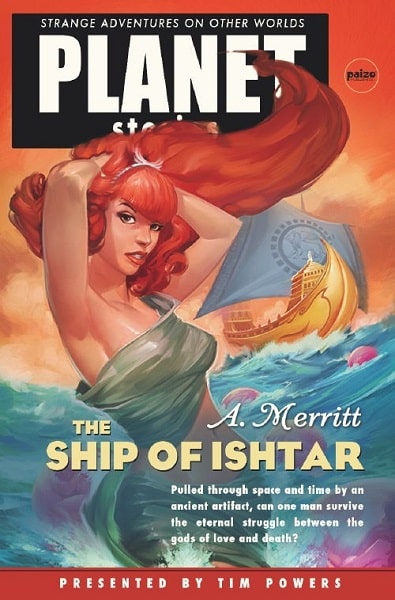 |
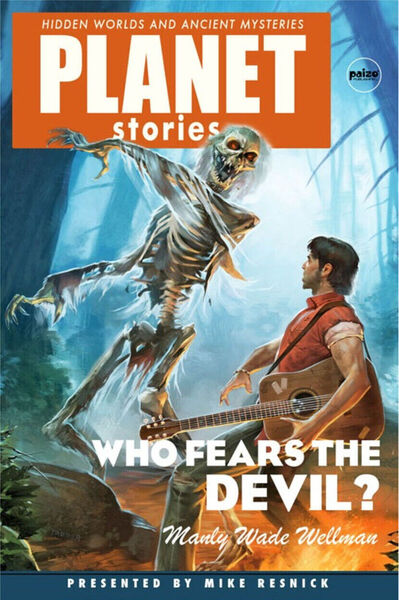 |
Planet Stories titles published by Erik Mona at Paizo: Robots Have no Tails by
Henry Kuttner (2009), The Ship of Ishtar by A, Merritt (2009), and Who Fears the Devil
by Manly Wade Wellman (2010). Covers by Tomasz Jedruszek and Kieran Yanner
I first became familiar with the Avon Fantasy Reader while hunting down rare stories for Paizo Publishing’s Planet Stories classic fantasy imprint, which I edited and published a little over a decade ago. That line focused heavily (but not heavily enough, alas!) on the early decades of the 20th century, following in the footsteps of folks like Wollheim and Gnaedinger. Over 33 books, we published classic and lesser-known works by authors like Merritt, C. L. Moore, Henry Kuttner, Manly Wade Wellman, and others, many of whom appeared in the Avon Fantasy Reader. I’d deeply enjoyed my first foray into this material years ago, and the near-completion of the series at this year’s Windy City was all I needed to start where I always like to start — at the beginning.
While discussing my take on the first issue at the show, Black Gate editor John O’Neill suggested that I type up my thoughts and share them with the readers of this august magazine, which I have endeavored to do below. These jottings represent my first impressions only, and provide a survey for those interested in taking the plunge as well as those who own dog-eared copies of the magazines and are simply pleased to see anyone discussing a magazine that came out 76 years ago.
I trust Black Gate’s audience has a healthy mixture of both types.
Acknowledgments Page for Avon Fantasy Reader #1
Without further preamble, here are my thoughts on the stories in the first issue of the Avon Fantasy Reader.
Murray Leinster’s “The Power Planet” is a weird choice to headline Wollheim’s brand new fantasy anthology series, in that it is a straight-up science fiction story involving a space station, rockets, international military intrigue, and some fairly stock pulp-era characters. I wonder if Wollheim viewed Leinster as a more contemporary and commercial writer than many of the others in this debut issue (the marquee cover credit would seem to suggest this, as well as the tale’s prime placement).
Honestly, I think he just liked the story.
A complete set (18 issues) of Avon Fantasy Reader, published 1947-1952
And there’s a lot to like. I haven’t read much Leinster, but what I have read has been capable, thoughtful “idea” sf with enough action to keep things interesting. “The Power Planet” is just such a yarn, featuring the crew of a distant space station that focuses and sends energy to Earth via a giant beam. There’s a war raging on the planet, and the crew of the station — cut off from communications — knows little more than that an enemy ship is approaching them at full speed. But who is the enemy?
Naturally, some elements of the story come across as dated to today’s reader, particularly insofar as its treatment of the only female character (the daughter of the President of the United States, no less!) is concerned. Other bits of scientific jargon are a bit grating to the modern ear, but are fairly typical of the sort of 1940s science-fiction this tale so reminded me of.
Only this wasn’t written in the 40s, but in 1931. That’s somewhat remarkable, as Leinster’s writing and technological prognostication seem at least a decade ahead of his time. If someone told me that the story came from the 50s I’d find it more plausible than the truth.
Back covers to Avon Fantasy Reader #1-18
Overall, “The Power Planet” is a good story. A fun story. But it’s a lame way to open a fantasy magazine, as it contains no non-scientific fantasy whatsoever. I know Wollheim included science fiction in his grand list of every sort of fantastic romance imaginable, but it’s a bit of a bummer to start things off with a story that wouldn’t even be considered fantasy by most modern readers.
August Derleth’s “The Shuttered House” is a simple but effectively written ghost story. That’s it. A decent little 11-page ghost story about a couple moving into a house haunted by its former inhabitants. I haven’t read a TON of Derleth, but I don’t think I’ve ever read a single one of his stories that made me think he was in any way exceptional as a writer. This struck me as competently done filler stuff for a horror magazine.
So we start with a straight up interplanetary science-fiction story and follow-up with a by-the-numbers little horror tale. It’s ok for what it is, but what it is probably shouldn’t be the second story in the first issue of a new fantasy anthology magazine. I’m more forgiving here than with the Leinster story (which is more interesting and better written), because ghost stories and supernatural horror are closer in spirit to fantasy than science fiction is, but it’s still an odd fit. OK.
Avon Fantasy Reader #1-6. Covers by Hannes Bok (#3), others unknown
William Hope Hodgson’s “The Voice in the Night” is one of the most eerie and effective weird tales I’ve yet read. I absolutely loved it. A couple of sailors on a fishing boat in the mid-Pacific encounter another vessel, invisible in the fog, rowed by a weak-voiced and extremely furtive stranger. The strange man begs for food but refuses to allow himself to be seen by the narrator and his crew.
He eventually tells the tale of his shipwreck on a nearby island with his new wife, their discovery of a wrecked vessel already on the island, and their slow realization that the boat and island are almost completely covered in a strange gray fungus. The fungus eventually starts to infect them, compelling them to devour the delicious stuff and they slowly turn into quivering blobs of fungus themselves.
This creepy story was the basis for the old Japanese horror movie Matango (a must watch), and easily is the best story of the first three. It’s also the first to introduce a non-hacky fantasy element, which helps to further propel it into the top tier. I have yet to read a William Hope Hodgson story I didn’t adore, and this one is probably my favorite so far. Highly recommended!
Avon Fantasy Reader #5, 6, 11 & 12 (1947-1950). Art: unknown, L.S. (#11) and M. Isip (#12)
Abraham Merritt’s “The Woman of the Wood” is the second longest story in the anthology after Leinster’s “The Power Planet,” and is the first of the opening four to be a classic “fantasy” story and not horror in a fancy mask. It is, like all of Merritt’s tales, written with an extremely lush and gorgeous style. Merritt uses more figurative language and metaphor in this story than all of the other authors in this volume put together, and then some. No doubt some readers would find it a bit overwrought, but I quite enjoy it. While reading Merritt’s prose you get a sense that he is operating on a higher literary level than most of his compatriots, which is probably why he was uniformly selected as the best of fantasy writers in pulp magazine letter columns through the 40s, and why he is less popular today, when readers are considerably less literate.
The tale concerns a World War I veteran recuperating in the environs of a secluded mountain lake lined with a copse of birch trees, the strange ancient family of lumber cutters on the opposite side of the lake, the weird forest spirits that inhabit the trees, and their endless war against the lumberers. The narrator is pulled into a lushly described otherworld where the spirits of the trees take bizarre (and ruthless) humanoid form, and Merritt’s language and mastery of style take you right there with him. I rank Hodgson’s “The Voice in the Night” slightly higher than this because I appreciate its economy and I’ve read Merritt I like more than this story, but “The Woman of the Wood” is very definitely in the top tier not just of this anthology but of the genre as a whole, and as the first “proper” fantasy in the magazine it deserves special commendation.
Merit for Merritt, if you will.
Avon Fantasy Reader #13 and 14 (1950). Covers by M. Isip and R. Crowl
“The Truth about Pyecraft,” by H. G. Wells, is the first story by this author I have read as an adult. Much more light-hearted than the previous four entries in this issue (all of which carry a fairly mournful tone), the 10-page yarn involves a rude, fat man named Pyecraft who wheedles the narrator to share one of his Hindustani great grandmother’s folk medicine cures to help him lose weight.
The narrator hates Pyecraft (largely because the man’s first interaction with him came off as racist — quite interesting in a tale this old) and spends the majority of the story griping about his rudeness, grossness, and stupidity. But he finally gives the man a hand-written, ancient prescription to make him lose weight. And lose weight Pyecraft does — not fatness, but weight.
When the narrator finally comes to call on Pyecraft again, the gross man is still corpulent, but now floats up to the ceiling, a near weightless being. It is, in the end, a lesson on being careful what you wish for. Wells does a great job with the characterization of his narrator and the eponymous Pyecraft, and this was a light, fun little fantasy story.
Avon Fantasy Reader #15 and 16 (1951). Covers by James Bama and R. Crowl
Clark Ashton Smith’s “The Vaults of Yoh-Vombis” was written in 1932, and is an excellent weird tale in the Lovecraftian tradition (of which Smith was a major — perhaps even superior — voice). The tale concerns a Martian colonist expedition and its exploration of the 40,000-year-old ruins of Yoh-Vombis, once a city of the proud predecessors of the current Martian race. There are echoes of Burroughs’s Barsoom here, and the tone and style is like a Leigh Brackett Burroughs pastiche meshed with a Lovecraft story about exploring an old tomb — which is to say I adore the setting and tone.
Despite the typically lush prose from Smith, the setting here seems a bit more matter-of-fact than some of the other science fantasies I’ve read from this author, which grounds the tale in an interesting way — it’s as much an adventure story as a tale of horror, and I appreciated the way the tones compliment one another. The plot is a typical Lovecraftian “let me tell you a story about something horrible that just went down” format, so of course you know the narrator is somehow completely doomed even though he somehow managed to find a way to explain exactly what happened to him before the final moments.
And what happened to him and his expedition is truly horrendous, involving the discovery of the cause of the ancient civilization’s fall—flat, cloak-like creatures of mold and fur that drop down upon the explorers, devouring their heads and puppeteering their bodies in a most horrific fashion. It is well and truly disturbing. It’s also fantastic — one of the best stories in what I am starting to consider a very impressive opening outing for Don Wollheim’s new fantasy magazine. Clark Ashton Smith is one of my favorite writers, and before I decided to complete the 18-issue run of the Avon Fantasy Reader I mostly picked up issues here and there because they featured one of his superlative stories. Happily for me, he’s in almost every issue, so there will be a great many more Smith stories to come as I work my way through the entire run.
Avon Fantasy Reader #17 and 18 (1951 & 1952). Covers by Harry Barton and unknown
“The Central Figure,” by H. Russel Wakefield, involves a brief manuscript from a patient at an insane asylum that recounts a tale of childhood obsession with a toy theater, the persistent unaided toppling of a wooden figure of a woman within it, and the story of the author’s evolution into an adult playwright who manifests his childhood theater dreams into an actual performance that unwittingly mimics the falling figurine from his youth. One of three figures in the author’s central play ends up shooting and accidentally killing the woman he loves, who throws herself in front of his rival at the last second, taking the killing blow. Of course, when the play hits dress rehearsal, the tragedy of the author’s fantasy replays itself in the real world, and a man is killed. Eventually it is revealed that the narrator was the killer, and that he had manifested an alternative identity of the playwright.
I know nothing of Wakefield’s writing or history. There are some fine touches here and there to his style that make the brief story an ultimately enjoyable read, but it seems to me that the conclusion of the story undercuts its fantastic element in a way that undermines my ultimate enjoyment of the yarn. Easily my least favorite story in the anthology so far, though with an editor as capable as Wollheim even the stories that don’t hit perfectly in this issue are still enjoyable enough. That’s my review of this story: Enjoyable enough.
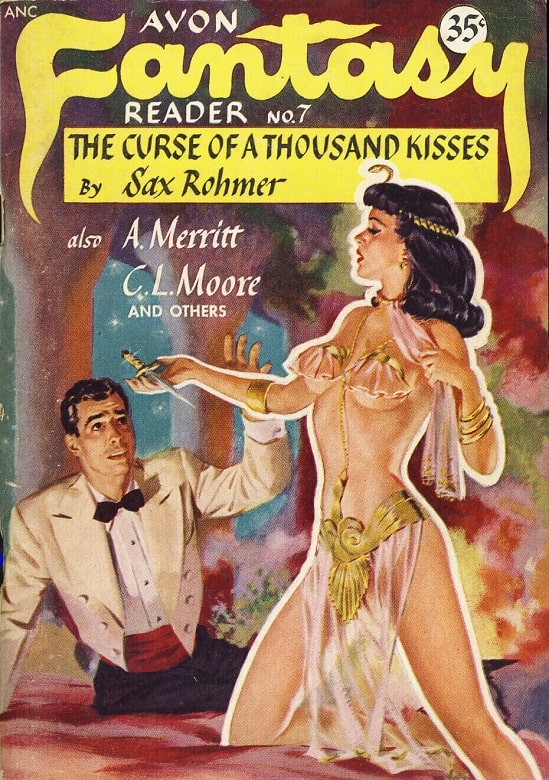 |
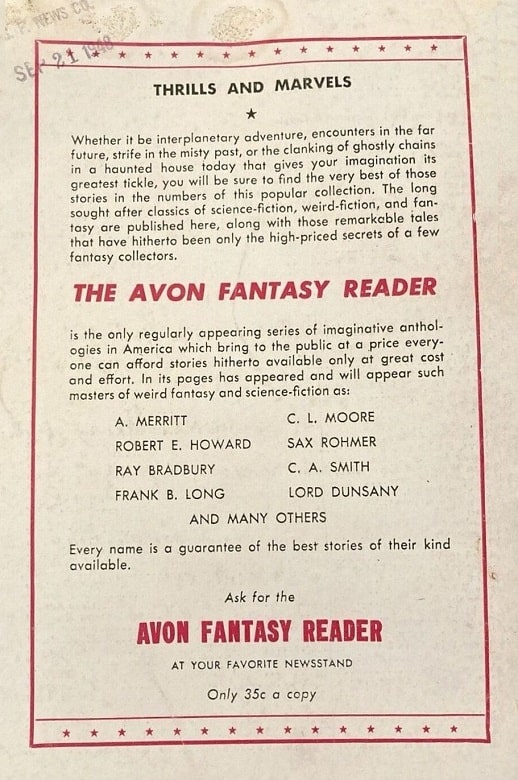 |
Avon Fantasy Reader #7 (Avon Books, 1948). Cover artist unknown
The final tale in this first Avon Fantasy Reader is “The Three Infernal Jokes,” by the famous Irish fantasist Lord Dunsany, one of H. P. Lovecraft’s greatest influences. The yarn involves a man who makes a deal with an agent of the devil, trading his virtue in exchange for three jokes guaranteed to make those who hear them die of laughter. Naturally the deal goes sour, as these sorts of bargains always do, and the man soon learns that the devil’s words are not to be taken metaphorically.
After debuting the first joke in an attempt to gain some clout at a social club, the man kills 22 people. Then, when the judge overseeing his trial asks him to recount the joke in court and it bombs, the man is compelled to read the second infernal joke, killing everyone in the courtroom and beating a hasty retreat to become a guilt-ridden wanderer of country roads. That’s where our narrator comes in, having met the man on just such a path. To our benefit, the narrator wanders away quickly so as not to hear any funny business from the poor comedian.
Dunsany’s tale has the air of a ghost story, and is remarkably charming in nature. I found it to be a fun diversion and very fitting for the fantasy theme, but ultimately pretty light and forgettable, especially when compared to the superlative offerings of Hodgson, Smith, and Merritt. A fine finish for a strong — if somewhat disjointed — opening to Avon’s exciting new anthology series.
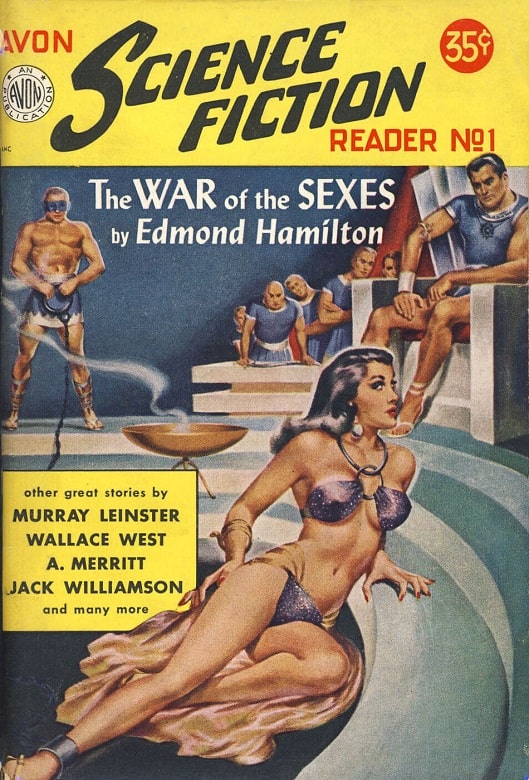 |
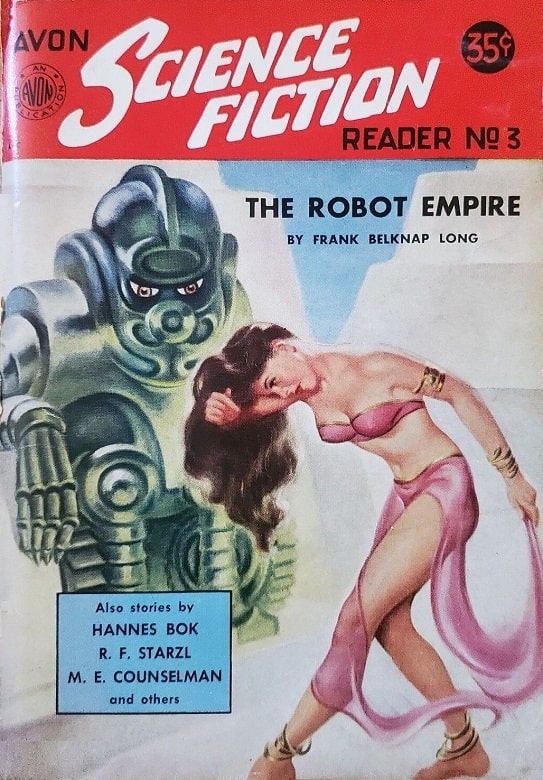 |
Avon Science Fiction Reader #1 and #3, edited by Donald A. Wollheim
(Avon Books, April 1951 and January 1952). Covers by R. Crowl and Earle Bergey
Here are my final rankings of the stories:
EXCEPTIONAL
1. The Voice in the Night, by William Hope Hodgson
2. The Vaults of Yoh-Vombis, by Clark Ashton Smith
3. The Woman of the Wood, by A. Merritt
QUITE GOOD
4. The Power Planet, by Murray Leinster
5. The Truth about Pyecraft, by H. G. Wells
6. The Three Infernal Jokes, by Lord Dunsany
7. The Shuttered House, by August Derleth
OK
8. The Central Figure, by H. Russel Wakefield
The only Avon Fantasy Reader cover art known to survive:
Ann Cantor’s cover to issue #9, illustrating Clark Ashton Smith
“The Flower-Women.” Courtesy Doug Ellis.
Erik Mona is the publisher and chief creative officer of Paizo, publishers of the Pathfinder and Starfinder roleplaying games. A decade ago, he edited Paizo’s Planet Stories line, which republished dozens of classic fantasy and science fiction novels. He owns a lot of books and old magazines and other weird stuff.
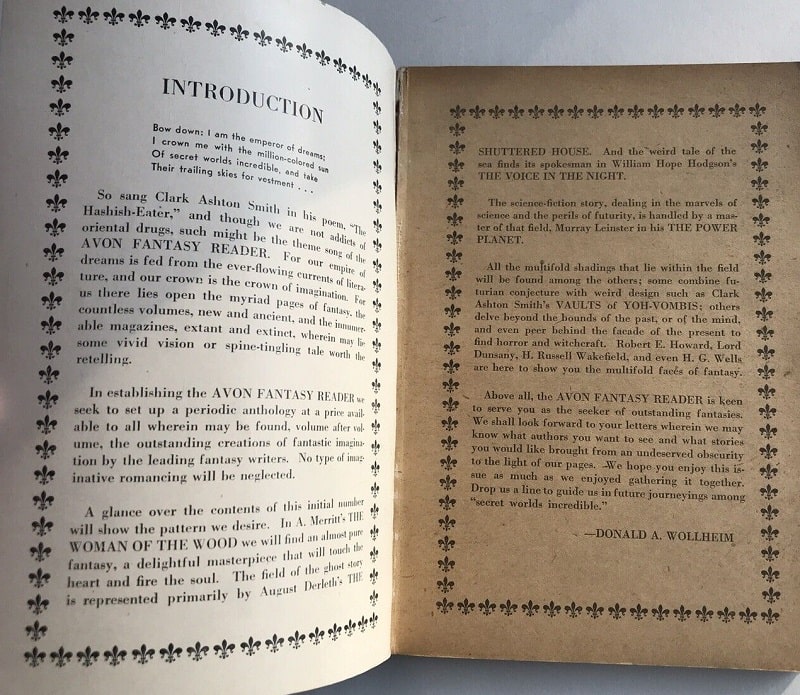
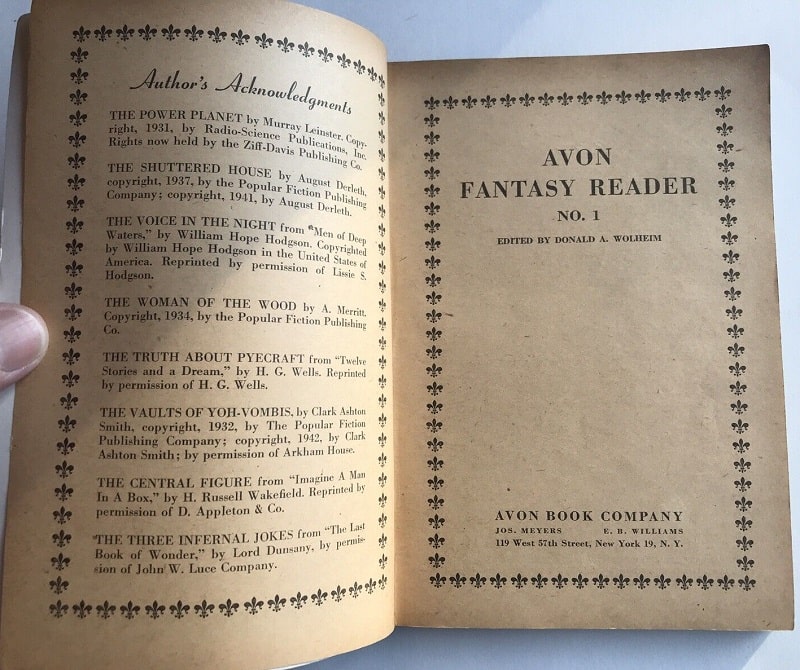
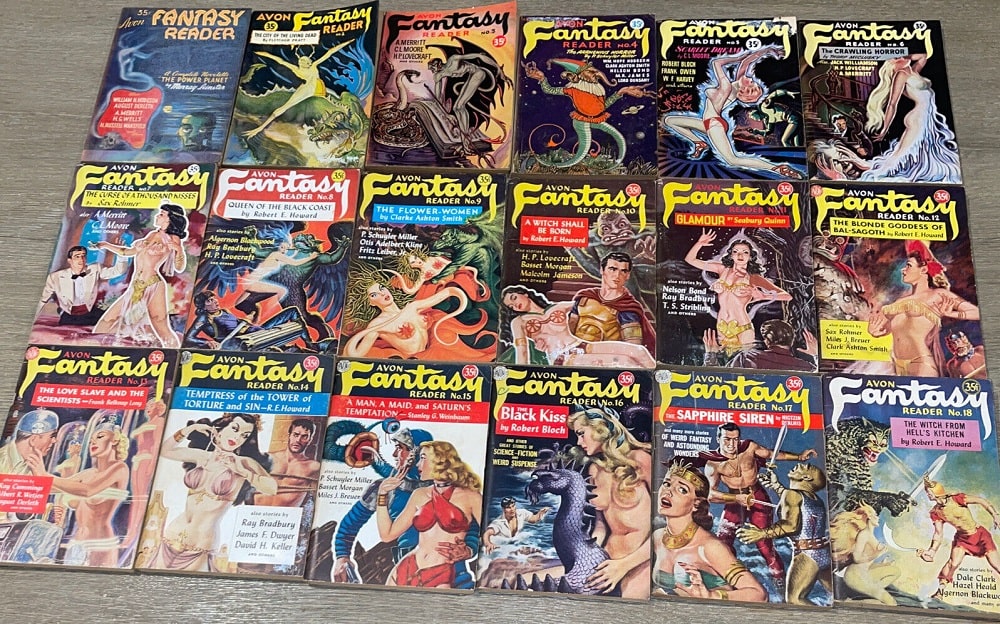
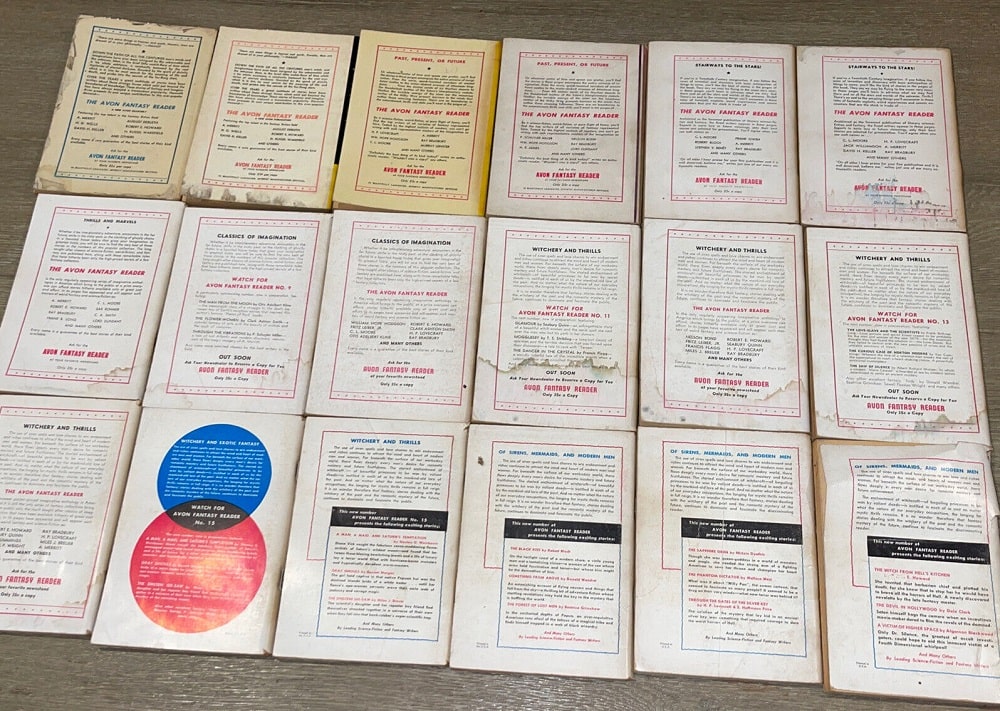
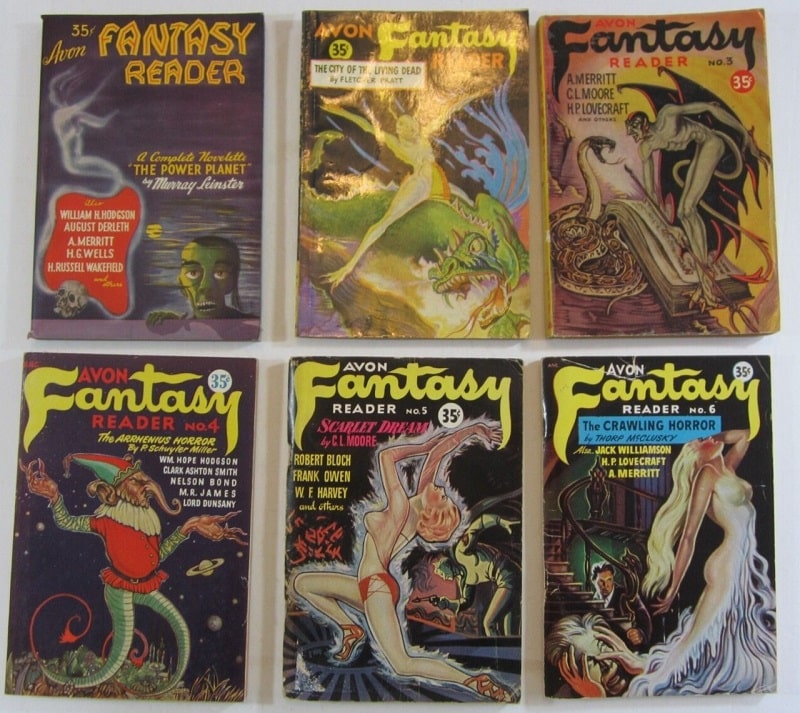
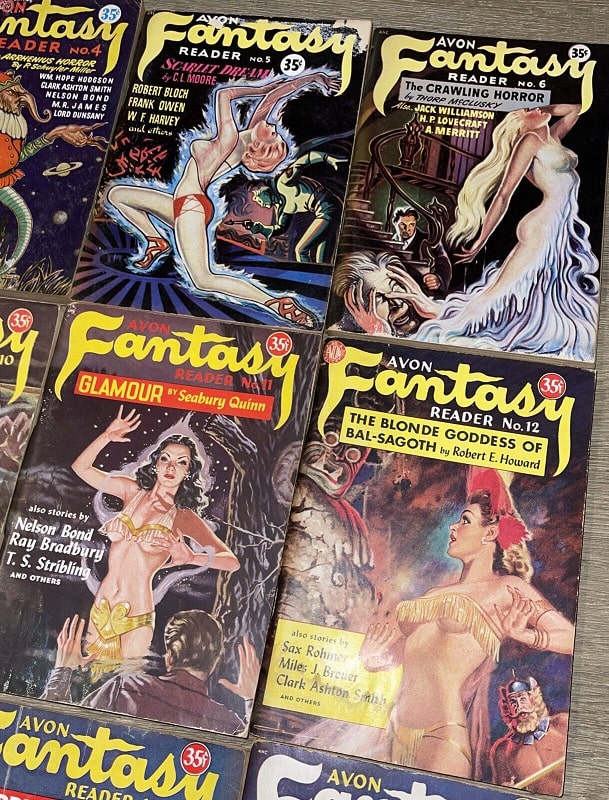
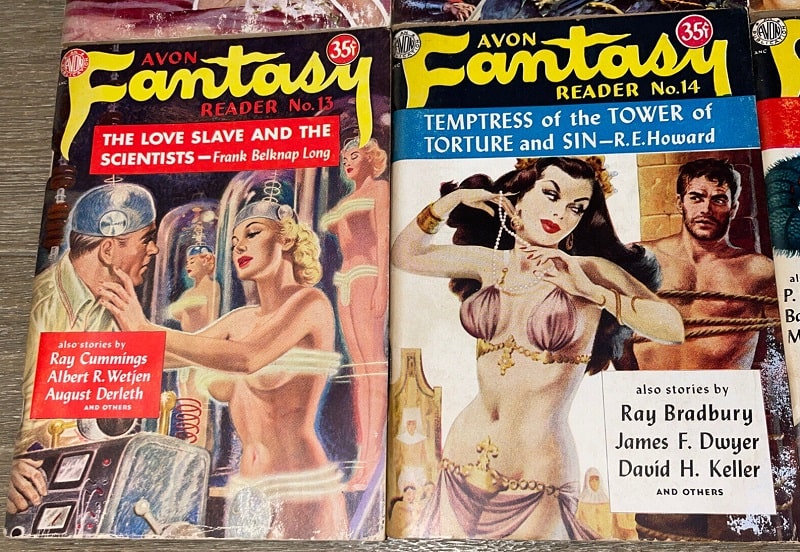
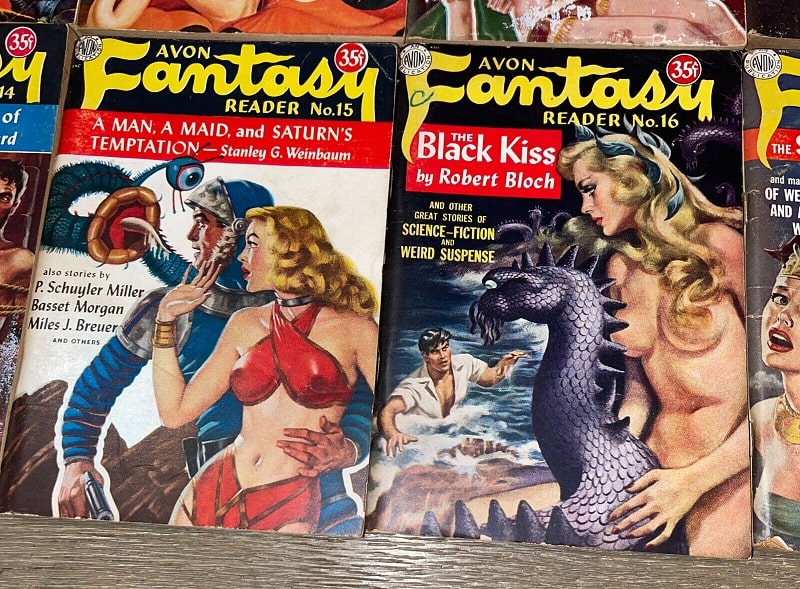
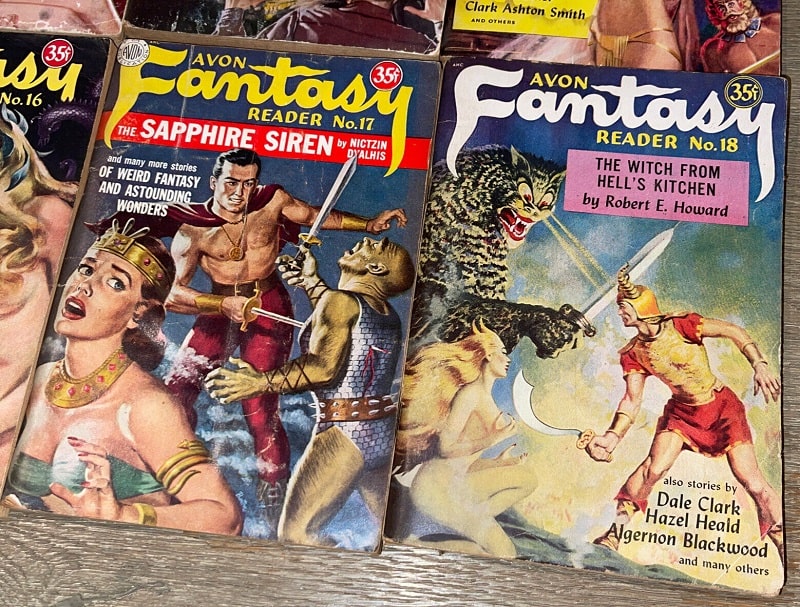
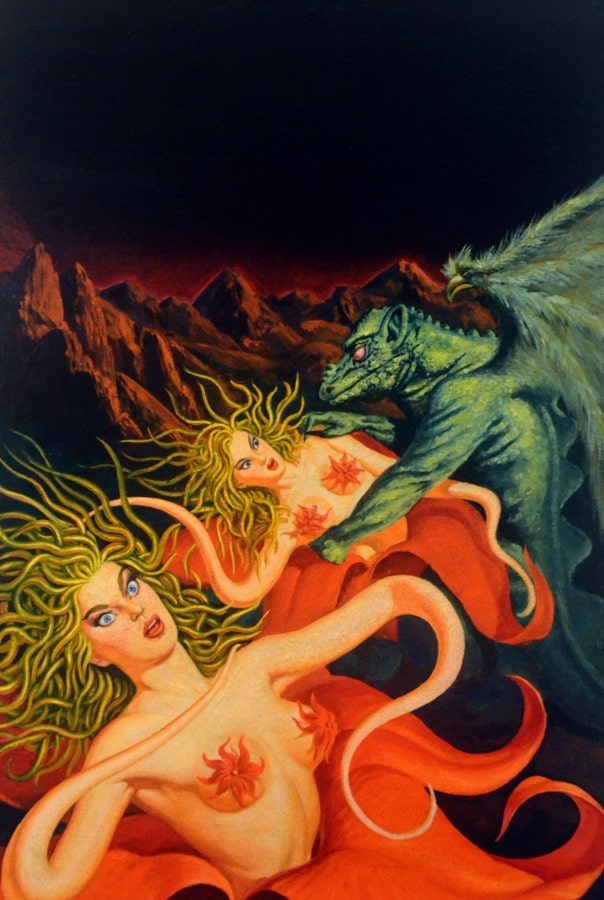
Curious how David H. Keller is one of the “draws” listed on Issue #1, but he does not show up on the cover until #14. Was he that popular and that hard to buy? Robert E. Howard, another “draw”, squeaks in ahead of Keller in Issue #12.
He was quite popular, but at this stage he was mostly retired, I think.
He was IMO the most interesting of the magazine SF writers before 1935, writing sociologial SF when the rest wrote gadget stories and “super-science” stories. But his horror and fantasy stories were better written.
To me H. Russell Wakefield is the curious name. I don’t think I’ve ready anything by him.
A cogent analysis and a fun trip down (a haunted) memory lane – AFR was one of my favorites back when I was a collector. I had most of the run, but never systematically hunted down the rest. Their paper covers make them very hard to find in decent condition.
Wollheim was always ready to tuck sf under the fantasy umbrella, or vice verse, as convenience or sales-figures allowed.
Glad you found some of you long-desired items!
[…] (Black Gate): The Avon Fantasy Reader ran 18 issues, from February 1947 to March 1952. Originally intended as […]